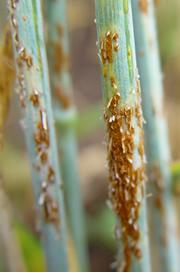A fungus that destroys the wheat plants begins to spread slowly in Africa and the south of the Arabian Peninsula
 Wheat (as we know) is one of the most important food bases. An adult person (in the Western Hemisphere) consumes about 500 calories a day that come from wheat. Eight years ago, a fungus (fungus) was discovered in Africa that damages wheat, and causes wilting by penetrating the plant's tissues and destroying them. The fungus is called Puccinia graminis and received the nickname Ug99 because it was seen in Uganda in 1999.
Wheat (as we know) is one of the most important food bases. An adult person (in the Western Hemisphere) consumes about 500 calories a day that come from wheat. Eight years ago, a fungus (fungus) was discovered in Africa that damages wheat, and causes wilting by penetrating the plant's tissues and destroying them. The fungus is called Puccinia graminis and received the nickname Ug99 because it was seen in Uganda in 1999.
Fields attacked by the pest immediately lose more than 40% of the crop, and if the pest is not eradicated, the entire crop is lost. The pest was recently discovered in Yemen. The spores of the fungus are light and spread in the air, and thus with the help of winds the pest rose to the Horn of Africa region and from there "jumped" over the Egyptian Bab-el-Mandab to the Arabian Peninsula. The move to the Arabian Peninsula is like going up the "main road" to the world's wheat growing centers, according to researchers, within about four years the pest will reach South Asia: to countries like Pakistan and India where wheat is the first important crop.
The pest can be destroyed using fungicides, but these are expensive to the point of being economically unviable.
About fifty years ago, a similar pest hit the wheat fields of North America and caused the destruction of crops, the development of wheat varieties resistant to the pest allowed the breeders to continue cultivating their fields, but the resistant varieties did not give large crops, so after a while the breeders returned to wheat varieties that may be vulnerable to the pest, and today are unknown Varieties that are resistant to the new pest.
Resistant varieties contain genes that encode a protein that identifies the pest and destroys the plant cells in which the pest is found, together with if the cells are destroyed the pest is thus stopped from spreading. The development of a resistant strain will take several years... In other words, today we are in a race between the wheat breeders who develop resistant strains, and the fungus spores that spread through the fields at the speed of the wind.
Experts estimate that until the pest is eradicated, the wheat growers will suffer losses that will reach billions of dollars... The researchers who identified the pest and the front in which it advances work in the Global Rust Initiative, which originates from the International Maize and Wheat Improvement Center Located near Mexico City. According to them "the pest is spreading like a slow tsunami".
Norman Borlaug, winner of the Nobel Prize in 1970 for his work to improve food crops, says that "the spread of the pest shows how important it is to preserve species (and varieties) of plants so that they will serve as a genetic pool for future improvements, for this purpose international cooperation is needed that will lead to the establishment of an archive pests and harms from the past to prevent their harm in the future"
A genetic pool that will include pests and resistant strains will prevent a future race like the one taking place today against the African fungus.

2 תגובות
Of course also: "Together if it suited" Chal: "with".
Urgent correction: the *hardy* varieties may cost a fortune, but they themselves are certainly not property owners and wealthy... buy from ALAF to IAAN (even though ALAF has already become a celebrity...)